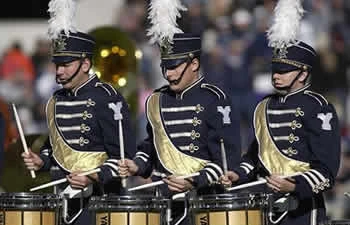The drumline in a band, also known as battery, is a percussion section of a marching band usually consisting of a snare line, tenor line, bass line, and a cymbal line. They usually keep steady tempo with the band and provide rhythm to base the music off of, especially if marchers can't see the Drum Major.
Bass Line[]
The bass line gives the band its tempo, for the most part. There are a range of bass drums, ranging from largest to smallest, usually consisting of 4 to 6 bass drums. Marching bass drums are most frequently used as tonal drums split between several percussionists. Each drummer plays a unique part, though the entire bass drum part is conceived as a whole. Marching bass drums, which produce the deepest sound in the battery, are larger drums carried on harnesses with the heads facing the front and back sidelines. The musicians carrying the bass drums typically line up in size order. Bass drummers use mallets with rounded or cylindrical heads often made of hard felt. Small bass drum lines typically consist of four or five members to ensure enough for a melody, while large lines can have eight or more drummers.
Snare Line[]
The snare captain is usually known as the drum captain. They are the most well recognized of all the drumline. Marching snare drums have high tension heads typically made of Kevlar or PET film, though it isn't uncommon to see carbon fiber heads. In the past, snares were typically carried with slings, and because of the tilt performers used traditional grip. Most modern snare drums have rigid over-the-shoulder harnesses that hold the drum with the playing surface parallel to the ground, which affords the option of performing with matched grip.
Snare parts are typically unison and provide the center rhythm of the drumline. The snare drum line is the center of tempo in the ensemble, and the "center snare", a position typically held by the most experienced snare drummer, is responsible for maintaining the tempo. When rehearsing or performing, the center snare may "tap off" the ensemble, setting the tempo with a solo rhythm.
Tenor Line[]
The tenors are some of the most elite percussionists in the band because there are multiple drums to play for one person. Contemporary tenor drums (also called toms, quads, or quints) are usually single-headed tonal drums mounted four to six to a set. Tenor players add pitch variety to the drumline with drums of different sizes and tuning. Tenor players use matched grip, and generally play with mallets with plastic disc-shaped heads, though traditional drumsticks and softer mallets are commonly used to achieve different timbres. Tenor drummers typically play in unison.
Cymbal Line[]
Marching cymbals are typically pairs of crash cymbals played in a variety of ways. Cymbals are bronze with leather carrying straps. Players in cymbal lines may all carry the same size and type of cymbal, or a variety of instruments may be used. Cymbals are played being held before the body, in unison or split parts. In addition to being played by the cymbalists, snare drummers may play on the cymbals as ride cymbals or like hi-hats, thus there is typically a minimum of one cymbalist for every two snare drummers. Cymbals are also used for visual effects due to their reflective surfaces. Many contemporary field ensembles do not utilize a cymbal line, as cymbals can also be played in the front ensemble.
Marching Xylophone[]
Some bands have marching xylophones, which are optional.

A Snare Line marching.